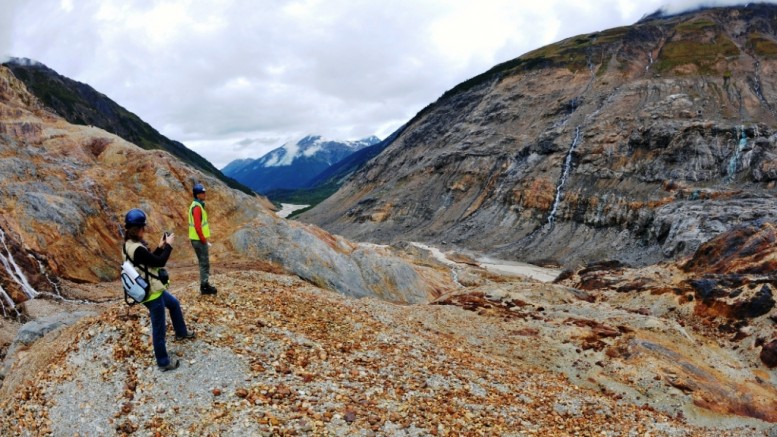CEO Rudi Fronk says 2014 should be a big year for Seabridge Gold’s (TSX: SEA; NYSE: SA) KSM gold–copper project in northwestern B.C.
Some of this year’s objectives include: publishing an initial resource estimate for the Deep Kerr deposit, receiving an environmental-assessment approval, initiating another round of exploration and drilling, and hopefully securing a joint-venture partner for the sizable project.
Located 70 km north of the town of Stewart, KSM hosts four large gold–copper porphyry deposits: Mitchell, Sulphurets, Kerr and Iron Cap. Altogether, the deposits have reserves of 38.2 million oz. gold and 9.9 billion lb. copper from 2.2 billion tonnes grading 0.55 gram gold and 0.21% copper. The project also has significant silver and molybdenum credits.
“When you look at the size of the system it is already one of the top-five largest gold–copper systems in the world. The size is just mind-blowing,” Fronk says.
What’s recently been generating excitement around KSM is its Deep Kerr deposit, where drilling returned total metal values per tonne that were more than double KSM’s reserve average.
The Toronto-based firm discovered the high-grade core zone under the Kerr deposit in 2012, but starting defining it in 2013. Last November a drill hole from Deep Kerr returned an impressive 640 metres of 0.85% copper and 0.42 gram gold per tonne, including 51 metres of 3.07% copper and 1.4 grams gold.
So far, drilling at Deep Kerr has confirmed more than 1.5 km of strike length and over 500 metres of vertical extent, Fronk says, noting the deposit is up to 600 metres wide in some areas.
“We already have well over a billion-tonne potential at Deep Kerr. We will be announcing an initial resource estimate from there within the next several weeks, which I think will surprise the market in terms of how big it is already and how high the grade is.”
Meanwhile, the company is coming towards the end of its environmental assessment (EA) review after working for years with local communities, First Nation groups, and Canadian and U.S. regulators to ensure its proposed mine at KSM meets environmental standards and has local support. It filed a lengthy EA application in early 2013, and anticipates regulatory approval by mid-2014.
In June the debt-free firm will kick off a $17-million exploration program to follow up on last year’s results from Deep Kerr, Iron Cap and other targets on the project.
It punched six holes at Iron Cap in 2013 as part of its aim to discover a core zone such as Deep Kerr below the deposit. “Evidence strongly suggests that the Iron Cap deposit sits above and is displaced to the south–southeast of a near-magmatic, high-grade core zone,” Seabridge stated in a release.
While the drill efforts last year didn’t hit a core zone at Iron Cap, the last three holes returned encouraging results from below the existing resource, with the best intercept carrying 253 metres of 0.9 gram gold per tonne and 0.37% copper. Seabridge believes follow-up drilling could add higher-grade material and boost Iron Cap’s value.
Commenting on the results, Fronk notes expanding the size of Iron Cap has a positive impact on the KSM project. He explains that the deposit, which would be mined from underground, is near the proposed haulage tunnel and other key infrastructure.
KSM is envisioned as a combined open-pit and underground block-caving mining operation with an estimated 55-year mine life. According to an updated 2012 prefeasibility study, life-of-mine production should average 508,000 oz. gold, 147 million lb. copper, 2.2 million oz. silver and 1.1 million lb. moly a year. Getting the mine up and running comes with a US$5.3-billion price tag.
“Yes, we have a large, upfront capital, but when you look at that amortized over the number of ounces we have, it is a capital-efficient project,” Fronk argues. “Based on the existing KSM reserves of 2.2 billion tonnes containing 38 million oz. gold, the all-in production cost — including the $5.3 billion of capital, the sustaining capital over the mine life, the operating costs plus the closure costs — is less than $700 per oz. The industry cost today is just over $1,000 per oz.”
To fund and develop what could become Canada’s largest mine, Seabridge is looking for an experienced company to joint-venture the project with, and is talking to interested parties.
Fronk says the Deep Kerr deposit has grabbed the attention of base-metal companies, adding that before the discovery, most of the interest for KSM was coming from gold firms. “For the first time we have a number of big base-metal companies interested in what we are doing and in what we have, and that has definitely been game-changing for us.”
The company’s CEO is adamant that Seabridge will not begin construction until it has a joint-venture partner in place, something it is hoping to find this year.
Asked if the company is willing to sell the project, Fronk said that “I have been in the business for more than 30 years, and this is a spectacular project that we have, and once it is up and running, it is going to produce metals for way more than 50 years. We would like to stay involved with this project as a joint-venture partner. Our intention is not to sell it.”
Along with KSM, Seabridge owns the Courageous Lake gold project in the Northwest Territories. It has US$25-million cash-on-hand.


Be the first to comment on "Seabridge expects a ‘big year’ at KSM"